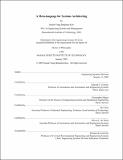| dc.contributor.advisor | Edward F. Crawley. | en_US |
| dc.contributor.author | Koo, Hsuehyung Benjamin, 1967- | en_US |
| dc.contributor.other | Massachusetts Institute of Technology. Engineering Systems Division. | en_US |
| dc.date.accessioned | 2005-09-26T15:57:14Z | |
| dc.date.available | 2005-09-26T15:57:14Z | |
| dc.date.copyright | 2005 | en_US |
| dc.date.issued | 2005 | en_US |
| dc.identifier.uri | http://hdl.handle.net/1721.1/27877 | |
| dc.description | Thesis (Ph. D.)--Massachusetts Institute of Technology, Engineering Systems Division, 2005. | en_US |
| dc.description | This electronic version was submitted by the student author. The certified thesis is available in the Institute Archives and Special Collections. | en_US |
| dc.description | Includes bibliographical references (leaves 164-168). | en_US |
| dc.description.abstract | (cont.) To demonstrate its practical value in large-scale engineering systems, the research applied OPN to two space exploration programs and one aircraft design problem. In our experiments, OPN was able to significantly change the modeling and architectural reasoning process by automating a number of manual model construction, manipulation, and simulation tasks. | en_US |
| dc.description.abstract | The aim of this research is to design an executable meta-language that supports system architects' modeling process by automating certain model construction, manipulation and simulation tasks. This language specifically addresses the needs in systematically communicating architects' intent with a wide range of stakeholders and to organize knowledge from various domains. Our investigation into existing architecting approaches and technologies has pointed out the need to develop a simple and intuitive, yet formal language, that expresses multiple layers of abstractions, provides reflexive knowledge about the models, mechanizes data exchange and manipulation, while allowing integration with legacy infrastructures. A small set of linguistic primitives, stateful objects and processes that transform them were identified as both required and sufficient building blocks of the meta-language, specified as an Object-Process Network (OPN). To demonstrate the applicability of OPN, a software environment has been developed and applied to define meta-models of large-scale complex system architectures such as space transportation systems. OPN provides three supporting aspects of architectural modeling. As a declarative language, OPN provides a diagrammatic formal language to help architects specify the space of architectural options. As an imperative language, OPN automates the process of creating architectural option instances and computes associated performance metrics for those instances. As a simulation language, OPN uses a function-algebraic model to subsume and compose discrete, continuous, and probabilistic events within one unified execution engine. | en_US |
| dc.description.statementofresponsibility | by Hsueh-Yung Benjamin Koo. | en_US |
| dc.format.extent | 168 leaves | en_US |
| dc.format.extent | 5113686 bytes | |
| dc.format.extent | 5116548 bytes | |
| dc.format.mimetype | application/pdf | |
| dc.format.mimetype | application/pdf | |
| dc.language.iso | en_US | |
| dc.publisher | Massachusetts Institute of Technology | en_US |
| dc.rights | M.I.T. theses are protected by copyright. They may be viewed from this source for any purpose, but reproduction or distribution in any format is prohibited without written permission. See provided URL for inquiries about permission. | en_US |
| dc.rights.uri | http://dspace.mit.edu/handle/1721.1/7582 | |
| dc.subject | Engineering Systems Division. | en_US |
| dc.title | A meta-language for systems architecting | en_US |
| dc.type | Thesis | en_US |
| dc.description.degree | Ph.D. | en_US |
| dc.contributor.department | Massachusetts Institute of Technology. Engineering Systems Division | |
| dc.identifier.oclc | 60843969 | en_US |
